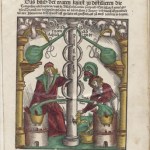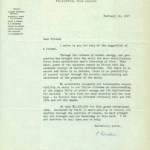history of science
How can you turn a monkey into a man? By feeding it "Rex" Brand Extract of beef, of course!
I might just have to throw in a bid on this Victorian promotional card. In bizarre fashion it combines several mythical elements common to popular depictions of human origins; that we evolved in a straight-line fashion, that consumption of meat made all the difference in our transformation, and that men "led the way" in the evolution of our species. Each of these misconceptions has been cast out of the scientific arena in turn, but they still pop up from time to time, especially in advertising.…
"the whole point of the Exploratorium is for people to feel they have the capacity to understand things." --Frank Oppenheimer
I admit it: I'd never heard of Frank Oppenheimer until I received my review copy of K.C. Cole's Something Incredibly Wonderful Happens: Frank Oppenheimer and the world he made up. I thought for a day or two that it was a book about Robert Oppenheimer, the so-called "Father of the Atomic Bomb," and was thus completely befuddled by the book's cheery title and its cover - a fanciful cloud of iridescent bubbles.
Of course, I was off by a sibling. Frank Oppenheimer was…
Many of the commenters on my earlier post about the so-called wisdom of crowds, "Science is not a democracy," have expressed distaste for the phrase "scientific consensus." I don't really share that distaste, and here's why.
To me, it's like being disturbed by the phrase "electoral college." You may detest the way our nation's electoral system works; you may not trust the outcomes it produces; but there is an established system, and the electoral college is part of it. You can object to the existence of the electoral college and criticize its characteristics, and you can try to change the…
A restoration of the skull of "Pithecanthropus" erectus by Manonvrier.
"Pithecanthropus" erectus, described by the Dutch anatomist Eugene Dubois, was an immediate sensation. Known from a skullcap, a femur, and a tooth discovered on the island of Java, it was the first fossil that could be regarded as an "intermediate type" between humans and apes (even if there was some debate about whether all the parts Dubois had found really went together). In later years "Java Man" would become more popularly represented by sculpted busts of our prehistoric relative, but one of the earliest full…
There was perhaps no Victorian naturalist so well-known and so misunderstood as Richard Owen. He could be warm to friends, but to his scientific peers he was an obstinate autocrat. He was among the first scientists to start publicly considering life in evolutionary terms, yet he never fully demonstrated the mechanism by which his evolutionary visions might be carried out. He crossed swords with theologians who were rankled by the implications evolution, but at the same time Owen fancied himself as a "high priest" of science. Neither here nor there, neither warm nor cold, Owen was seemingly a…
Here in the Northern Hemisphere (of Earth), today marks the Winter Solstice. Most people have some understanding that this means today is the day of minimum sunlight, or the longest night of the year. Fewer people, I think, have a good astronomical sense of why that is the case.
So, in honor of the solstice, let's do some old school astronomy. Really old school.
Let's consider the two-sphere cosmos:
To the ancients, it was perfectly reasonable to assume the earth is stationary. (Indeed, it wasn't until Galileo that there was a really persuasive argument that an Earth-in-motion was…
The National Library of Medicine's "Turning the Pages" gallery lets you turn the virtual pages of classic science/medicine manuscripts. Check out Hieronymus Brunschwig's Liber de Arte Distillandi de Compositis (1512):
Note that the NLM's copy is hand-colored; uncolored copies also exist, such as this copy at ECHO. Comparison with the images of the ECHO copy show that NLM has elided the boring, text-only pages from their animation.
I'm not usually a big fan of animations that try to replicate the tactile experience of books, but given that you aren't usually allowed to touch manuscripts of…
Albert Einstein has never reminded me much of Dr. Evil. Quite the opposite, in fact. But even Einstein occasionally had to ask for one MEEEEL-LION dollars - for a good cause, of course:
Dear Friend:
I write to you for help at the suggestion of a friend.
Through the release of atomic energy, our generation has brought into the world the most revolutionary force since prehistoric man's discovery of fire. This basic power of the universe cannot be fitted into the outmoded concept of narrow nationalisms. For there is no secret and there is no defense; there is no possibility of control except…
Much of my forthcoming book is steeped in insights about evolution that have been derived from the new paleobiological synthesis, and in doing a bit a background reading I came across an interesting tidbit.
In 1980 numerous authorities on evolutionary science converged in Chicago for a conference on macroevolution. Spurred by the work of paleontologists such as Niles Eldredge, Stephen Jay Gould, David Raup, and Steven Stanley, the meeting's goal was to assess whether the traditional slow-and-steady model of evolution preferred by geneticists fit what paleontologists saw in the fossil record.…
The skull of Paranthropus boisei ("Zinj," "Dear Boy," "Nutcracker Man," etc.).
Louis Leakey had a problem.
During the summer of 1959 he and his wife Mary recovered the skull fragments of an early human scattered about the fossil deposits of Olduvai Gorge in Tanzania. The skull had been deposited among the shattered bones of fossil mammals and a collection stone tools, and this led Louis to conclude that it was one of our early ancestors. Only an ancestor of Homo sapiens could be a toolmaker, Louis thought, but the skull looked nothing like that of our species.
When Mary fit all the pieces…
Today is the 150th anniversary of the publication of Charles Darwin's On the Origin of Species by Means of Natural Selection, and there is a whole list of things I am not going to do;
I am not going to set aside time to read On the Origin of Species when I get home.
I am not going to write a long ode to Darwin in which I pontificate on how his view of nature changed science and society.
I am not going to stop by any Darwin-themed parties, lectures, or other events.
And so on. I really do not have any special celebratory plans for today at all. Instead I intend to honor the work of Charles…
Last couple of weeks months were awfully busy, on many fronts, not least finalizing the ScienceOnline2010 program, herding cats almost 100 moderators/presenters to do various stuff (e.g., respond to my e-mails) in a timely manner, and making sure that registration goes smoothly. This is also the time of year when activation energy for doing anything except going to bed to hide under the covers is very high for people suffering from SAD. Thus, you did not see many 'original' posts here lately, I know.
But, it's not that I have been totally idle. Apart from teaching my BIO101 lab again, I also…
The North Carolina Museum of Natural Sciences hosts the final offering of its Charles Darwin Lecture Series on Tuesday, November 24 -- the 150th anniversary of Darwin's landmark publication of "The Origin of Species." Join Museum paleontologist and science historian Paul Brinkman for a free presentation titled "Charles Darwin's Beagle Voyage and the Origin of 'The Origin.'"
Dr. Brinkman completed his PhD in History of Science at the University of Minnesota with research in the history of 19th-century natural sciences, especially geology and paleontology. He has published a number of articles…
A giraffe, photographed at the Bronx zoo.
For me, no visit to the zoo is complete without stopping by to see the giraffes. They are among the most common of zoo animals, certainly, but I still find them fascinating. If giraffes did not actually exist and someone drew an illustration of one as a speculative zoology project the picture would likely be written off as absurd, yet the living animal is more charming than preposterous.
As with many extant large mammals, though, the giraffe is only a vestige of a once more diverse group. Its closest living relative is the okapi, a short-necked and…
At last long there was solid proof that humans had died in a real Noachian Deluge. That such an event had occurred was widely taken on faith by Christians, and the belief that world's geology had been formed by the Flood was assented to by many naturalists, but in 1725 the Swiss naturalist Jacob Johann Scheuchzer believed that he had discovered a symbol so instantly recognizable that no one could doubt that the biblical catastrophe was real. It was what appeared to be a human skeleton, cleaved nearly in half but nonetheless preserved by the very floodwaters that had killed the sinner.
The…
NESCent and SCONC:
What: November SCONC-fest
When: Thursday November 19th , 6-8pm
Where: National Evolutionary Synthesis Center in Durham
Please join us to commemorate Charles Darwin's 200th birthday and the 150th anniversary of "The Origin of Species."
Learn about the wild world of Ice Age carnivores, brainy birds, and other creatures Darwin missed. Our tour guides will be four postdocs on the frontiers of biology.
We'll begin at 6pm at the National Evolutionary Synthesis Center in Durham. Parking is free.
National Evolutionary Synthesis Center (NESCent)
2024 W. Main Street, Suite A200…
During the past six million years or so several species of humans have simultaneously inhabited Earth at any one time, but today only one species, ours, remains. How did this come to be? This is the question behind part 3 of the NOVA documentary series "Becoming Human" (see my reviews for parts 1 and 2), and the show does not get off to a strong start.
Though I might be a little more merciful on the producers of this documentary than Greg, he was right to point out that the opening segment of the show is worn old tripe about how our species has fulfilled a kind of evolutionary destiny set in…
The display of horse evolution at the AMNH as created by W.D. Matthew. Price reproduced this illustration without permission in his creationist textbook The New Geology.
The 1925 Scopes "Monkey Trial" put scientists on the defensive. It did not matter that the defendant in the famous case, John Scopes, probably never taught evolution in a Tennessee school (he was only a substitute teacher and football coach who agreed to take the fall so that the ACLU could test a law that barred evolution from schools); the issue that everyone was concerned about was the conflict between science and…
If anything, the 19th century English paleontologist Gideon Mantell is known for his contributions to our understanding of dinosaurs. His most famous accomplishment was the description of Iguanodon, but Mantell has another legacy that is not as well-known. It was his last contribution to science, though it was not made willingly.
Like many other early paleontologists Mantell had to carve out his own career, and he studied fossils when not busy with his duties as a surgeon in the Lewes countryside. As Mantell began to gain recognition for his work on fossils, though, his passion for…
A mammoth as restored in Gosse's Omphalos. In Gosse's view of history, however, such a scene never actually existed. The bones of the mammoth existed in the earth from the time of Creation and had never given form to a living animal.
Without a doubt, Philip Henry Gosse's Omphalos is one of the strangest books I have ever read. Published in 1857, two years before Charles Darwin's On the Origin of Species would cause the public and academics alike to take evolution more seriously, Gosse's book was an attempt to rescue Creation itself from the perceived threat of science denuded of Christian…



